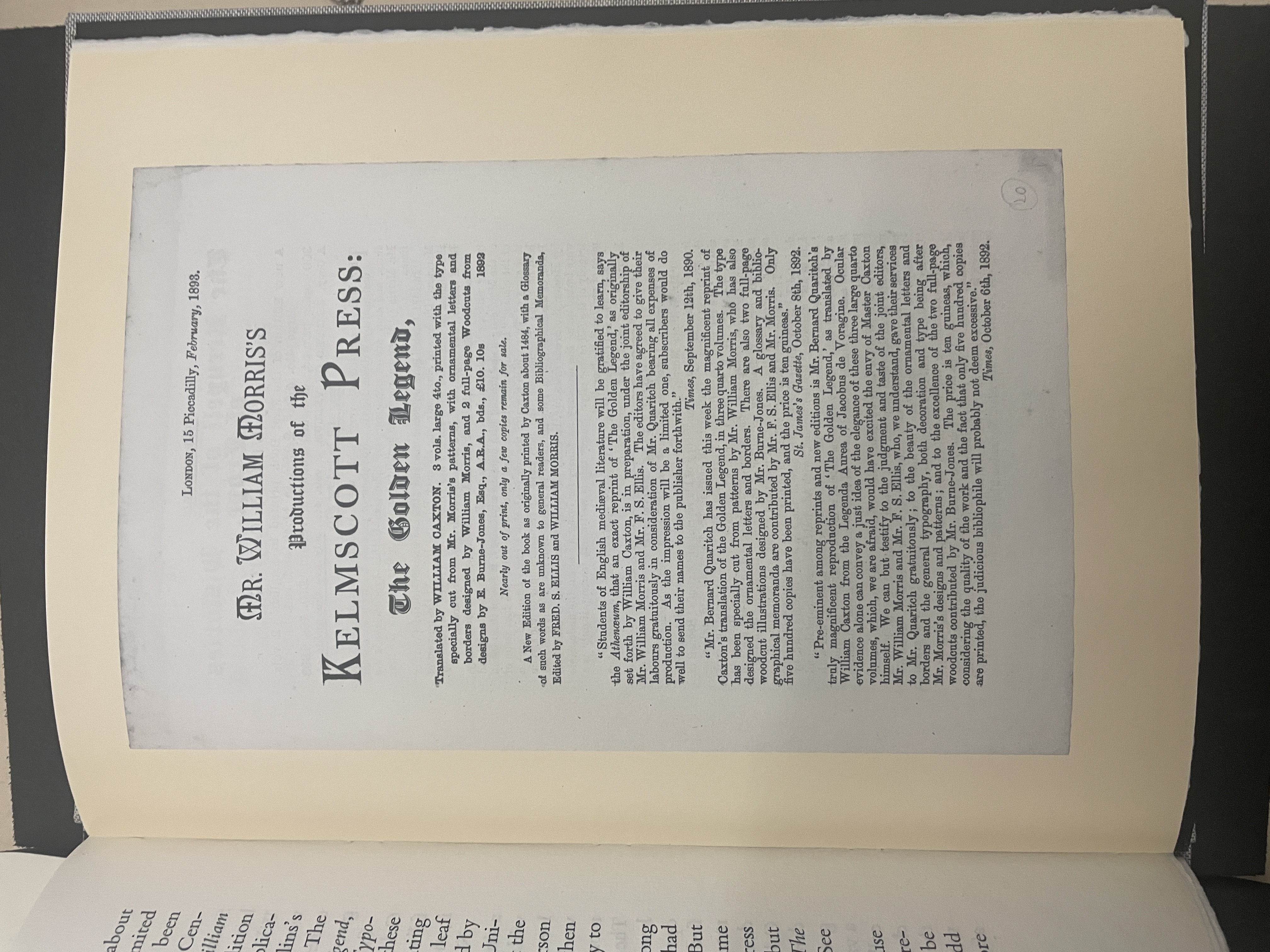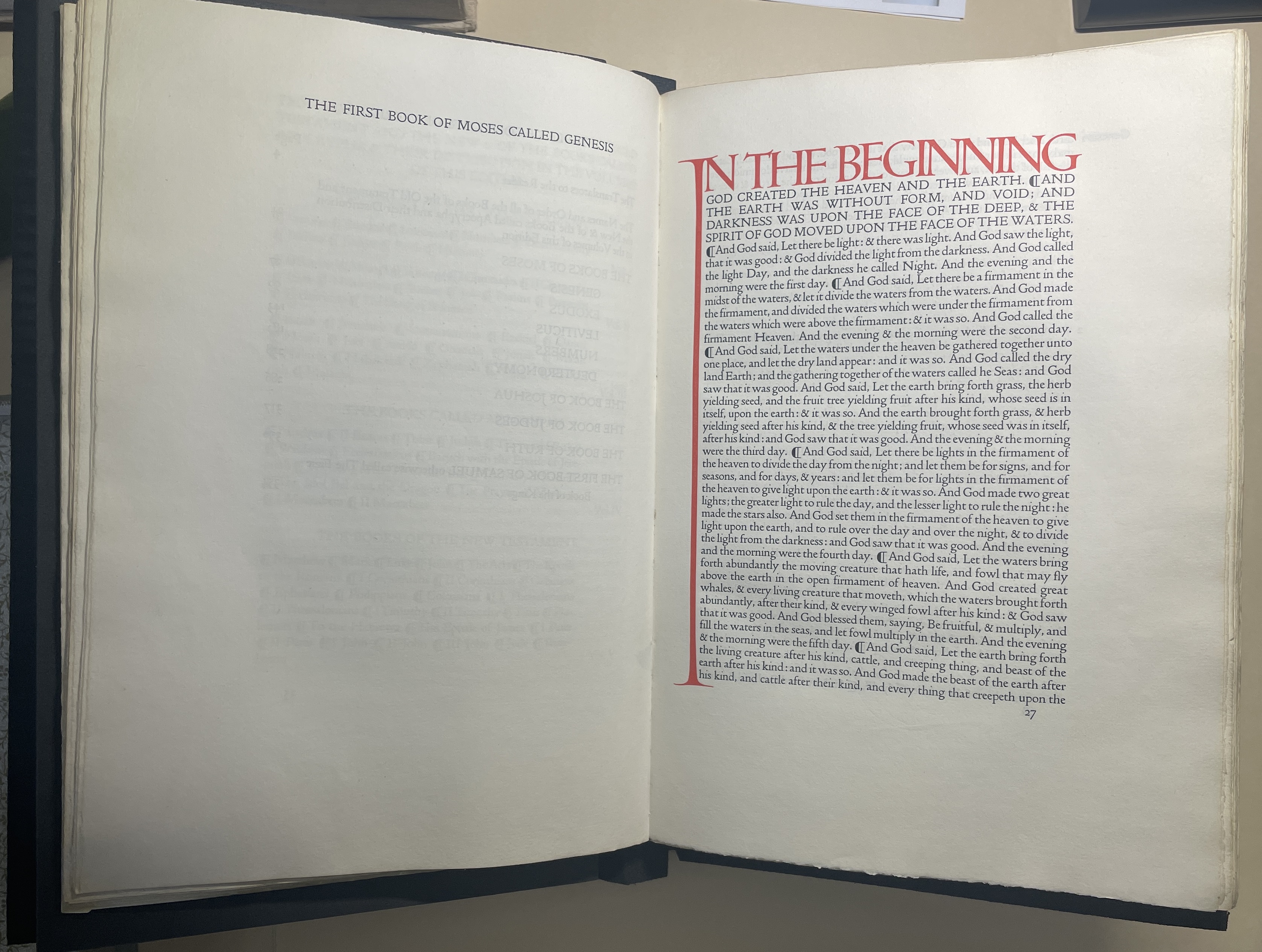In continuing the exploration of the history of the book through the holdings of Los Angeles Public Library’s Special Collections, this installment will cover three notable publishers of books: William Blake and his self-published books, Kelmscott Press (1891 – 1898) and Doves Press (1900 – 1916).
These books can be seen as complete works, with total consideration as a package of artwork, type, binding, and printing, and samples of these books can be found at the Central Library throughout the Central Library in person. For items that are in Special Collections, know that anyone can come to see those items by making an appointment using this online form.
Visionary, painter, printer, and poet William Blake (1757–1827) is ranked as one of the greatest poets of the English language and as one of the most influential artists of the time period. His bookworks were engravings that combined art elements from Renaissance artists, his Christian spirituality, and his poetry to create monumental works. He published his first book in 1789, Songs of Innocence. The poems were printed and illuminated by Blake himself, using his own handwriting and a drawing and engraving process done prior to the Industrial Revolution.

He is most famously known among schoolchildren for his poem "The Tyger" from his book Songs of Experience (1794). This book and the earlier Songs of Innocence (1789) were later combined and published in 1794. There are multiple facsimiles of these books available; this one from 2008 is based on scans from the copy located at the Huntington Library.

Blake’s original method imagery, "relief etching," as he called it, created a single, raised printing surface on a metal plate for both text and image. By doing this, Blake was able to write the verses, create the illustrations, print the plates, add additional colors to the pages by hand, and bind the books into covers. These "illuminated books" had very small print runs and were largely accessible through facsimiles. Below are two additional facsimiles of “illuminated books” available at the Central Library:


If you’re interested in seeing all of Blake’s illuminated books, please check out this book: The Illuminated Blake: All of William Blake's Illuminated Works With a Plate-by-plate Commentary. If you’re interested in a biography of Blake, check out The Stranger From Paradise: A Biography of William Blake.
William Morris (1834 – 1896) was a poet, artist, designer, socialist agitator, businessman, and printer. He is most famously known for his involvement in the Arts and Crafts movement, the artistic response to the shoddy products being manufactured during the Industrial Revolution. Morris founded his design and manufacturing firm in 1861, and it was in production until 1940. More information about Morris's designs in tapestries, wallpaper, fabrics, furniture, and stained glass windows can be found in William Morris and the Arts and Crafts Home.
Among bibliophiles, Morris, along with printer Emery Walker (1851 – 1933), is best known for his contribution to the private press movement with the founding of Kelmscott Press in 1891. With the Kelmscott Press, inspired by medieval illuminated manuscripts and early printed books, Morris published limited-edition illustrated books that met with his aesthetic ideals, such as having illustrations and text designed to be unified. Additionally, beyond the layout of the printed page, due to his meticulous nature, Morris was involved in the design of the paper and the typeface for these books. Morris also designed the initial letters, borders, and typefaces. Ultimately, the Press published 53 books in 66 volumes between 1891 and 1898. Each book was designed and ornamented by Morris and printed by hand in limited editions of approximately 300 copies.
William Morris sought, through the creation of the Kelmscott Press, to counter and resist the dehumanizing of mass production from the Industrial Revolution and its capitalistic pursuit of profit over quality and craftsmanship. Because of increased literacy, there was greater demand for reading material, leading to higher print runs and a fall in the quality of reproduction standards.
Part of the books that William Morris valued were those printed by Englishman William Caxton (c. 1422 – c. 1491) in the later half of the 15th century. Caxton, who, upon learning of the new printing technology of Johannes Gutenberg (c. 1393–1406 – 1468), was the first printer of the English language and promoted the standardization of the modern English language. Caxton translated and published now canonical English works such as Geoffrey Chaucer’s The Canterbury Tales, Jacobus’ The Golden Legend, and Sir Thomas Malory’s Le Morte d'Arthur. Morris, through Kelmscott Press, redesigned and reprinted a lot of Caxton’s printed works.
The most coveted and famous of the Kelmscott Press books is one of the Caxton books, the Kelmscott Chaucer, for which the Library owns a facsimile. The book is formally known as The Works of Geoffrey Chaucer and is more commonly referred to as the Kelmscott Chaucer. The book collects the work of Geoffrey Chaucer, including his famous Canterbury Tales. The book was printed in 1896 and is the culmination of Morris’ vision of his love of medieval literature and art. 425 copies were printed on paper, and another 13 copies were printed in vellum, with 46 bound in pigskin. The book contains 87 woodcut illustrations by Edward Burne-Jones and countless border decorations and decorated initials by William Morris.

In the above image, you can see examples of William Morris' artistic vision in the stylized manner of the Arts and Crafts Movement. William Morris designed the border ornamentation and the initials for the book using a plant motif. The engraving illustration pictured here and throughout this book is the work of painter Edward Burne-Jones, who illustrated all of the Kelmscott Press books. The typeface designed especially for the book is called "Chaucer," a Gothic typeface.
Another facsimile the Library owns is a commemorative book published after William Morris' passing in 1896. A Note by William Morris on His Aim in Founding the Kelmscott Press (1898) has two short essays about the Press and also a bibliography of all the books published by Kelmscott Press. In the bibliography, there are descriptions of the typeface, the printed material used, and the binding style.

In Special Collections, there is an actual Kelmscott Press book available for public viewing—the three-volume The Golden Legend published in 1892. The text for this book comes from Caxton’s 1483 English translation of Jacobus de Voraigne’s Golden Legend. The Golden Legend itself was originally published in Latin in 1265 and is a compilation of stories about the saints and Christian festivals. The Voraigne Latin text was translated into French by Jean de Vignay in 1334, and this translation became the basis of the Caxton edition.

Kelmscott’s The Golden Legend was to be Kelmscott’s first book published; however, it was beset with printing issues. The specially designed typeface for the book is appropriately called "Golden" and the book has a woodcut title and two woodcuts also designed by Edward Burne-Jones. The 3-volume book has almost thirteen hundred pages.

The Kelmscott Press Golden Legend: A Documentary History of its Production is a description of how The Golden Legend was published and it comes with a leaf from the Kelmscott edition.

The papers used in Kelmscott Press books were also made to William Morris’ exacting standard and vision from Batchelor came in various sizes, distinguished by different watermarks:
- Flower (16" X 11" and 16" X 22")
- Perch (17" X 23")
- Apple (18" X 13")

The bookbinder responsible for the bindings of the Kelmscott Press is T.J. Cobden-Sanderson (1840 – 1922), who, along with Emery Walker, after William Morris’ passing, started Doves Press. Doves Press is notable for its restriction to only one typeface, known as Doves Type.
In Special Collections, there is a copy of Doves Press’s English Bible: Containing the Old Testament & the New.

To learn about the artistic and design vision of Cobden-Sanderson, check out, The Ideal Book, or, Book Beautiful: A Tract on Calligraphy, Printing & Illustration and on the Book Beautiful as a Whole.
